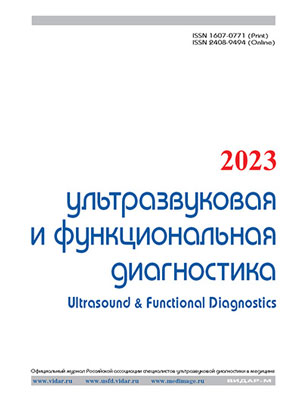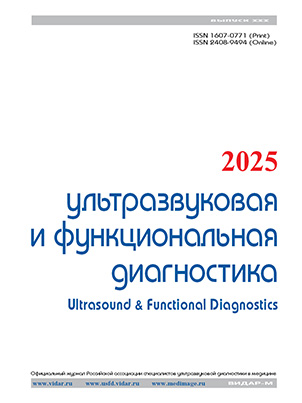
Scientific and practical peer-reviewed journal
The journal “Ultrasound and Functional Diagnostics” has been published quarterly since 1995. The journal is included in the List of Russian peer-reviewed scientific periodicals recommended by the Higher Attestation Commission for the publication of main scientific results of dissertations for the PhD (In Russ.: candidate of science) and the Doctor degrees in the specialties:
Scientific and practical peer-reviewed journal
The journal “Ultrasound and Functional Diagnostics” has been published quarterly since 1995. The journal is included in the List of Russian peer-reviewed scientific periodicals recommended by the Higher Attestation Commission for the publication of main scientific results of dissertations for the PhD (In Russ.: candidate of science) and the Doctor degrees in the specialties:
3.1.4. Obstetrics and Gynecology (medical sciences),
3.1.20. Cardiology (medical sciences).
The journal has been included in the List of the Higher Attestation Commission of the Russian Federation since the formation of the List (since 2001) (Bulletin of the Higher Attestation Commission of the Ministry of Education of the Russian Federation. 2002. No. 1)
The journal is intended for a wide range of specialists in ultrasound and functional diagnostic, as well as in other medical and biomedical specialties, who use ultrasound routinely.
Ultrasound is an advanced diagnostic modality, with wide availability, an optimal cost-result ratio and high rate of sensitivity and specificity, which provides widespread use of ultrasound in medical science and practice. Ultrasound shows an unprecedented rates of development. New techniques focused on improvement of diagnostic accuracy of ultrasound in various pathologies, including oncology, and on reducing of the number of invasive diagnostic procedures, including biopsies appears almost annually. Ongoing scientific research proving the informativeness of these techniques is necessary for implementation in clinical practice. There is a wide demand for ultrasound technologies in obstetrics and gynecology, cardiology, general and special surgery, oncology and other fields of clinical medicine.”
A rigorous, double-blind peer review by recognized experts is combined with detailed descriptions of errors, inaccuracies and inconsistencies and indications of rational ways to correct them. Particular attention is paid to the assessing of statistical data processing methods, the correctness of which is extremely important to obtain reliable results, satisfied the requirements of evidence-based medicine.
The journal presents original articles, clinical cases, reviews (including pictorial ones), clinical lectures, diagnostic guidelines, expert opinions, protocols and standards of ultrasound examinations, information about congresses, conferences, seminars, regulatory documents of the specialty, etc.
There is no charge for publications.
The journal “Ultrasound and Functional Diagnostics” is the official journal of the All-Russian public organization “Russian Association of Ultrasound Diagnostics in Medicine”
Current issue
General Ultrasound
Obstetrics and Gynecology Ultrasound
Cardiovascular Ultrasound
Announcements
2024-12-18
Подписка на журнал на 2025 год

Уважаемые читатели!
Открыта подписка на печатную версию журнала на 2025 год.
| More Announcements... |
















